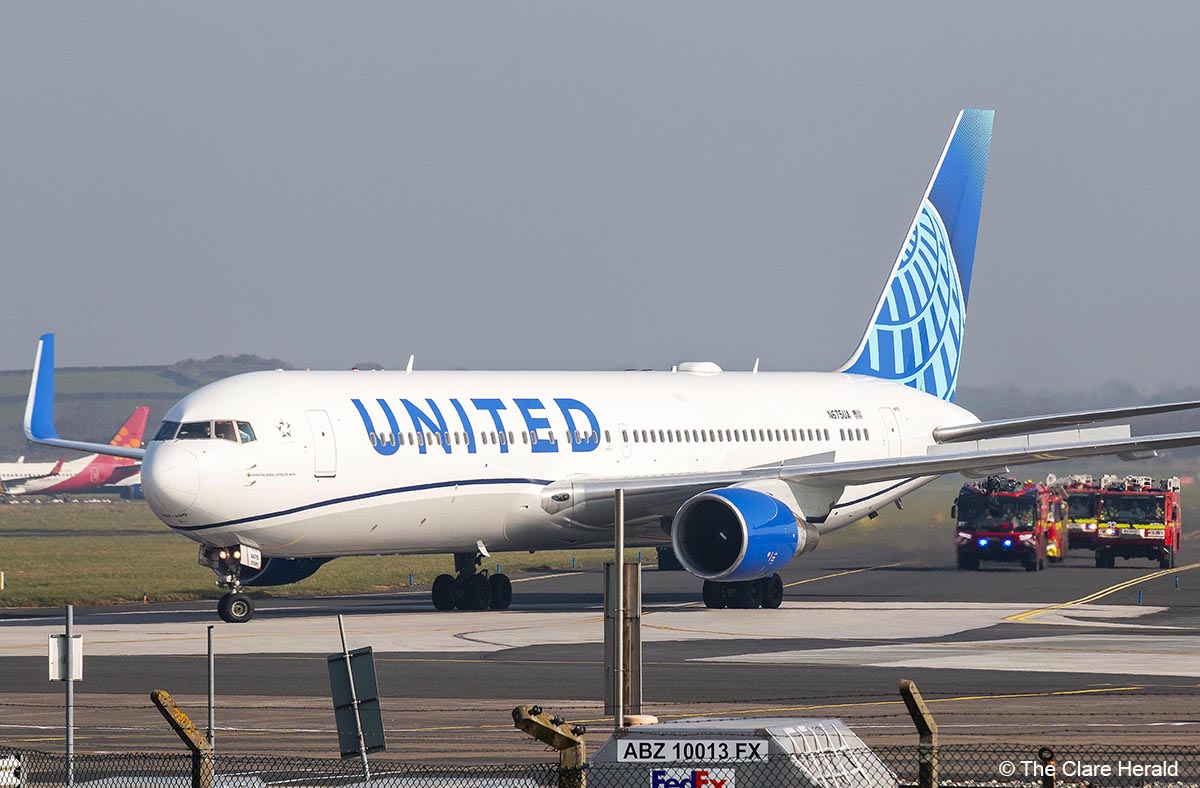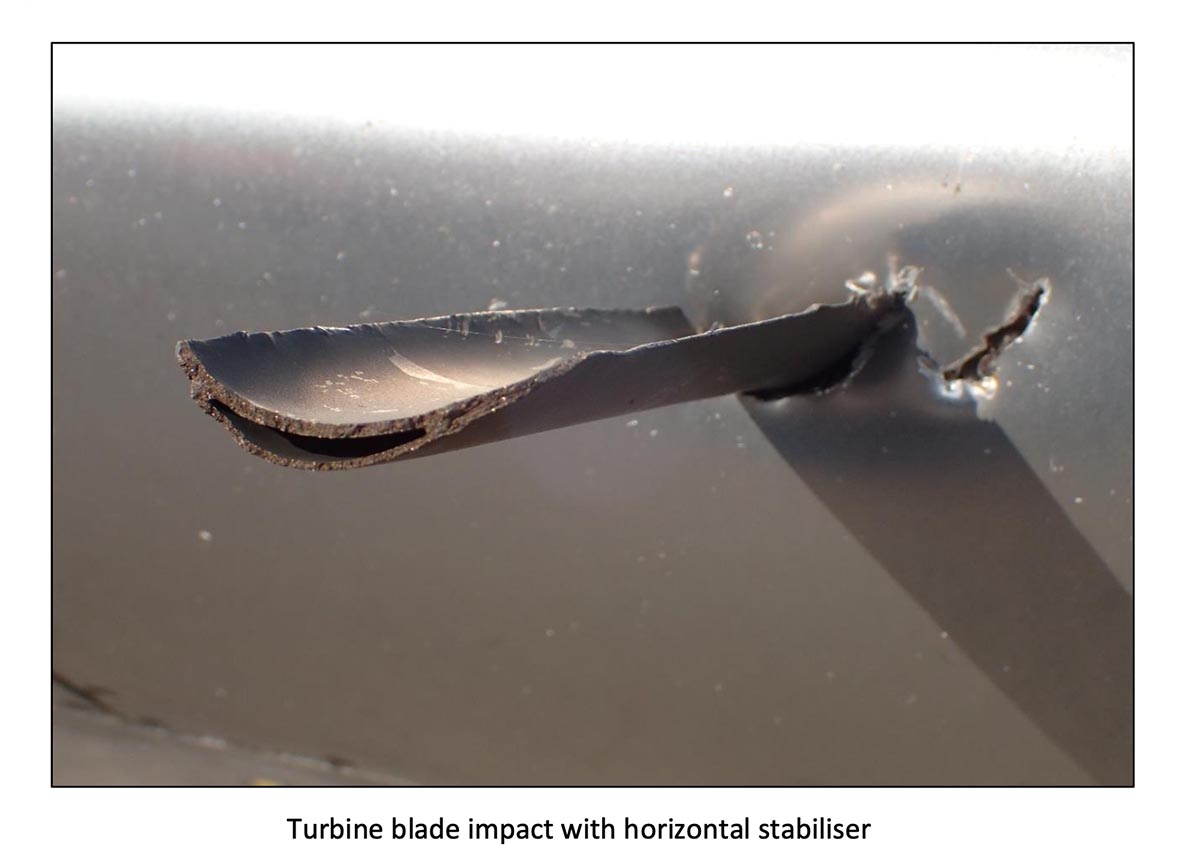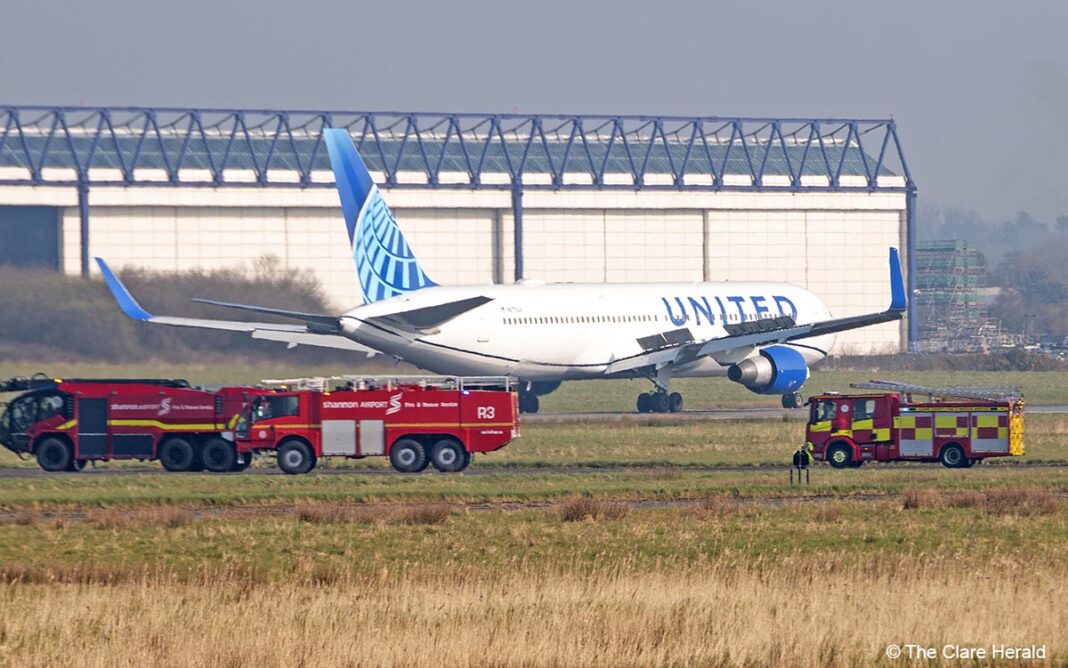A turbine blade that was ejected from the engine of a transatlantic jet became imbedded in the horizontal stabiliser of the aircraft after the engine ‘surged’ several times.
The Air Accident Investigation Unit (AAIU) of the Department of Transport has issued its final reported into incident which involved a United Airlines flight that made an emergency landing at Shannon Airport in 2022.
United flight UA-134 was travelling from Newark in the US to Zurich, Switzerland when the crew declared an emergency at around 9.00am on March 28th 2022. The Boeing 767-322(ER) jet was about 583 nautical miles (1080 kilometres) west-northwest of Shannon at the time. There were 116 passengers and a crew of 10 on board.
Soon after the flight entered Irish airspace, the crew transmitted an emergency ‘squawk’ 7700 radio signal indicating to air traffic controllers and other aircraft they had an emergency on board.
In the meantime, air traffic controllers and authorities at Shannon Airport implemented emergency procedures ahead of the aircraft’s arrival. This involved alerting the local authority fire service, National Ambulance Service and An Garda Síochána.
Units of Clare County Fire and Rescue Service from Shannon and Ennis stations were mobilised to the airport in support of Shannon’s own fire and rescue crews. Ambulance paramedics; rapid response advanced paramedic units and an ambulance officer were also dispatched to the airport.
Airport and local authority fire crews were mobilised to designated holding points adjacent to the runway in advance of the jet’s arrival. The flight landed safely at 10.40am on its one operating engine.

According to the AAIU report: “During the cruise phase of a scheduled passenger flight between Newark and Zurich, the right engine of the Boeing 767-322ER aircraft surged several times.
Due to abnormal indications on several engine instruments, the Flight Crew believed that the engine had been severely damaged. They completed the ‘Severe Damage’ checklist and shut down the engine. The Flight Crew made a MAYDAY transmission and diverted to the nearest suitable airport which was Shannon.”
“The aircraft landed safely and was escorted to a parking stand by the Shannon Airport Fire and Rescue Services. The passengers and crew disembarked normally, and no injuries were reported to the Investigation. There was no fire.”
Shannon Air Traffic Control notified the AAIU shortly after this occurrence. Two Inspectors of Air Accidents deployed to Shannon and commenced an investigation.
The report states: “In this occurrence, the right (No. 2) engine surged multiple times whilst the aircraft was in the cruise phase of a transatlantic flight. The Flight Crew immediately identified the affected engine, reduced the engine power of that engine to idle and commenced a descent. The two other pilots, one of whom was the Commander, were taking scheduled crew rest at the time of the engine surges but returned to the flight deck immediately when they became aware of the problem.
The four pilots then reviewed the situation together. They determined that the ‘severe damage’ checklist was applicable and worked through this checklist, which included shutting down and securing the affected engine. The Commander then resumed control of the aircraft and asked the most experienced of the other three Pilots to sit in the right seat and fulfil the role of pilot monitoring for the approach and landing. The diversion checklist was completed, and the aircraft diverted to Shannon where a single-engine landing was performed.
The aircraft was met by the Aircraft Fire and Rescue Services and taxied to stand without assistance. Detailed analysis carried out by the Engine Manufacturer determined that the surges were the result of a sequence of events initiated by distress in the No. 1 bearing of the right engine. The bearing outer race showed evidence of spalling. The Engine Manufacturer deemed it likely that spalling had also occurred in the inner race; however, secondary damage meant that this could not be definitively proven.
The distress to the No. 1 bearing caused it to vibrate at a frequency that was in the range of the first fundamental mode of the bearing oil supply tube. The associated resonance caused failure of the oil supply tube in high cycle fatigue. The No. 1 bearing subsequently failed due to oil starvation and overheating. The failure of the No. 1 bearing allowed the low-pressure rotor to move axially causing rotor clashing. This caused significant damage to the engine. The engine then surged four times. One of the turbine blades that was subsequently ejected from the engine impacted with the horizontal stabiliser causing minor damage.”
The Operator (airline) informed the Investigation that the time since overhaul of the No 1 bearing for this engine was 4,518 hours / 702 cycles. The Engine Manufacturer reviewed the procedures used for the overhaul and confirmed that they were consistent with recommended practice.

While the AAIU report does not make any conclusions, it does state that:
The Engine Manufacturer considered that the most likely sequence of events was:
- No.1 Bearing distress caused by spalling in the outer, and likely spalling in the inner race (the exact cause of the spalling could not be determined).
- No.1 oil supply tube fractured in high cycle fatigue, due to vibration in its first fundamental frequency range.
- Inadequate lubrication to No. 1 bearing caused by No. 1 oil supply tube fracture.
- No. 1 Bearing oil starvation and overheating, leading to raceway and ball wear.
- Aft axial shift of low-pressure shaft causing rotor clashing.
- Multiple engine surges.
- Impact of released turbine blade on horizontal stabiliser.
- Engine in-flight shutdown actioned by the Flight Crew.
